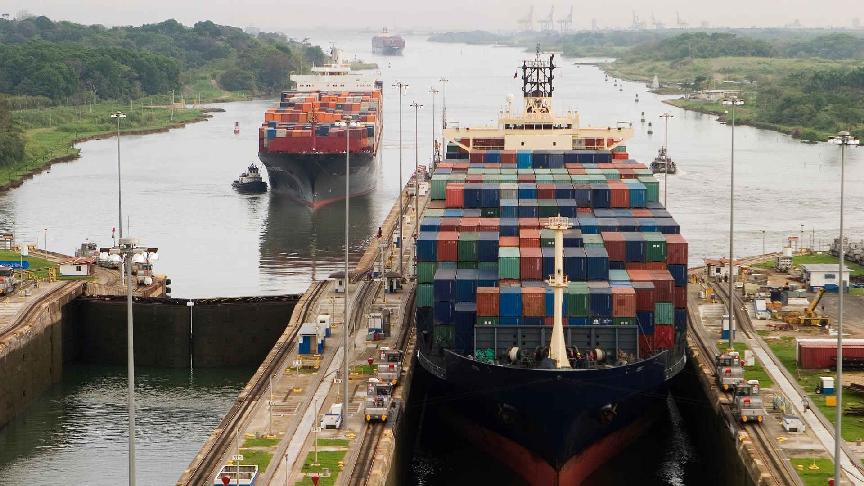7 November 2023 (Lloyd's List) - WITH unprecedented drought conditions expected to restrict Panama Canal transits far into 2024, shipowners are starting to consider rerouting fixed-day schedule services from Asia via the Suez Canal as executives brace for long-term disruption.
There is growing disquiet among regular canal users that, even if the current weather conditions reverse the recently announced restrictions imposed by the Panama Canal Authority (ACP), long-term investment in the canal still hangs in the balance and uncertainty is driving many to strategically review their reliance on the waterway.
The ACP has plans to spend $800m-$900m building a new reservoir, which could theoretically be operational in five years and increase the daily transit capacity by 11 panamaxes under normal weather conditions.
But while infrastructure companies have been commissioned to undertake engineering studies to support planned upgrades, final decisions are being mired in domestic politics and no approvals have yet been given.
Any project plans will needs to be approved by the National Assembly of Panama, which is up for election in May 2024 and few expect any decisions before the election.
While the current restrictions have been blamed on the El Niño weather phenomenon that has contributed to the severe drought, rising costs and the looming prospect of some vessel classes being priced out of the canal have angered shipowners who argue that investment in the canal has stalled even as costs have increased.
During the past few months container lines have incurred ongoing delays and cargo-loading restrictions for their vessels, many of which were bespoke designed to operate through the neo-panamax locks.
Average waiting time has reached 5.29 days for northbound voyages and 5.58 days for southbound in October, down from 9.52 days for northbound and 8.66 days for southbound in August but still historically high, according to the authority’s own data.
Now under pressure from customers in both Asia and North America who are reportedly complaining about schedule reliability, some lines are now understood to be lobbying the Panamanian government directly.
In a letter seen by Lloyd’s List, one major line executive directly lobbied Panama President Laurentino Cortizo Cohen to engage the industry on the issue as matter of urgency.
In the letter, the executive raised the prospect of vessels rerouting if transits are not increased and pointed out that no significant infrastructure projects to increase the supply of fresh water into the locks have gone ahead, but the costs and charges to the shipping lines have continued to increase.
The letter is not an isolated case of frustration with the ACP’s interactions with the industry.
The canal authority, in part, justified price increases in 2021 on the need to invest in new infrastructure to cope with the new ships and the impacts of climate change. Additional price rises due to the impacts of El Niño on top of climate change this year have left many questioning what happens next.
Lloyd’s List understands that several industry efforts are now in the works seeking clarity on when progress will be seen on infrastructure plans.
Since the canal’s most recent major expansion was completed in 2016, the volume of traffic through the Panama Canal has gradually increased. The maximum capacity of the Canal is 38 to 40 transits per day.
During 2022, ACP data showed an average of 35.4 daily transits, but due to the drought conditions transits had been reduced to 32 since the end of July.
Following last week’s announcement of additional restrictions that number will fall to 22 in December, 20 in January and then to just 18 in February.
The announcement of further cuts means neo-panamax capacity will go from about 10 to five affecting sailing routes for large containerships, VLGCs, LNG carriers and larger bulk carriers.
The priority given to containerships and LNG carriers means that VLGCs will increasingly be squeezed out of the canal. The impact of that will mean increased tonne-miles, increased disruption and higher freight rates.
While a change in the weather patterns could yet change the scenario planning, the current assumptions see little prospect of any improvement this year.
The droughts have come in what should have been Panama’s rainy season which typically lasts from May to November. With the dry season now here, the restrictions are anticipated to last until sufficient rain emerges to help ease the water levels. That is now not likely to happen until May 2024.
By February 2024 if the restrictions remain in place neopanamax slots with be down to just eight transits per day, which will mostly be taken up by container vessels with the occasional gas carrier.
According to brokers Poten, large oil tankers will not feature in this trade anymore. They will not be able to schedule in advance like containerships do and they can likely not compete for the auction slots, which last week hit a new record when a VLGC “won” a slot for $2.85m.
“The stark reduction in slots will push many of the tramp vessels (including tankers and dry cargo ships) away from the canal. This will lead to more tonne-mile demand and possibly changes in segment utilisation as longer hauls may stimulate the use of larger vessels,” said Poten.
In other trades the current impact is less pronounced, but will start to become an issue as the restrictions tighten.
In dry bulk restrictions through the Panama Canal are predominantly impacting the southbound trade in the region, nudging a shift in trade routes for the USG-China trade.
Drewry estimates a rise of 5%-6% in freight rates because of the diversion of soybean trade from the Panama Canal to the Suez Canal, with the rise in tonne-miles boosting the demand for dry bulk vessels.
As dry bulk transits comprise 23% of the total canal transits, the highest among all other sectors, the continual impact on the sector is inevitable, Drewry pointed out in a client briefing on Tuesday.







